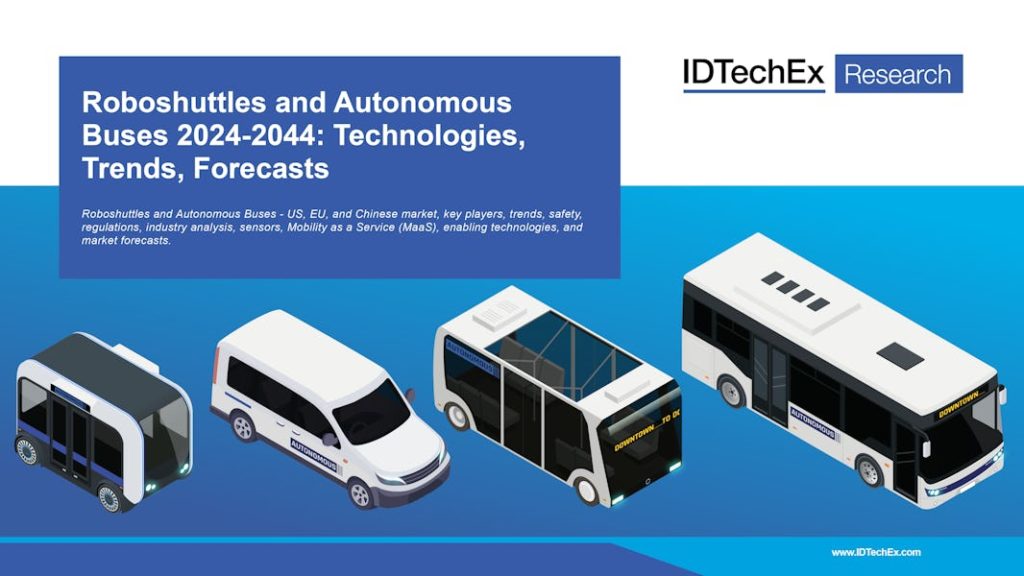For more information, visit https://www.idtechex.com/en/research-report/roboshuttles-and-autonomous-buses-2024-2044-technologies-trends-forecasts/1020.
-
Global Roboshuttles and Autonomous Buses sales revenue is to exceed US$67 billion by 2044.
-
Roboshuttles and Autonomous Buses – US, EU, and Chinese market, key players, trends, safety, regulations, industry analysis, sensors, Mobility as a Service (MaaS), enabling technologies, and market forecasts.
In recent years promise of a public transport revolution is being teased by autonomous buses and roboshuttles. These technologies promise to deliver significant cost reductions for operators and alleviate labor pressures. Although full commercialization remains some distance away, advancements in this sector hold substantial potential for addressing many current industry challenges. This report provides a comprehensive analysis of the roboshuttles and autonomous buses industry, highlighting critical challenges, market dynamics, and future outlook.
Critical Challenges in the Roboshuttles and Autonomous Buses Industry
The development of urban public transportation faces several significant challenges. The rising average age of urban populations exacerbates labor shortages, making it increasingly difficult to find enough drivers to meet demand. This issue is further complicated by the rapid pace of urban development, which creates new challenges for efficient and effective public transportation. Additionally, the continuous improvement of urban infrastructure demands innovative solutions that can adapt to evolving needs. Autonomous buses and roboshuttles offer promising solutions to these problems by potentially replacing drivers in all bus use-cases, supporting drivers in conventional buses, and providing fully automated services in specific operational design domains such as airports.
Replacing drivers with autonomous systems can significantly lower operational costs. Driver salaries constitute a considerable portion of the operational costs for any commercial vehicle, and autonomous technology can offer large potential savings in this area. Furthermore, autonomous technology promises to drastically improve safety by reducing the number of traffic accidents. Human error accounts for 90-95% of all incidents, and autonomy offers a future where traffic accidents are significantly reduced. Cost savings from autonomous technology could also make it feasible to serve previously unprofitable routes, improving mobility in underserved areas such as small villages.
Industry Dynamics and Market Shifts
The roboshuttles market has seen significant shifts in recent years. From 2020 to 2024, the number of players in the market halved, reflecting the typical lifecycle of emerging industry bubbles, where the transition from innovation to commercial viability presents significant challenges. Despite this decrease in player numbers, 2023 saw notable activity in the roboshuttles sector. European leader Navya was acquired and rebranded by a Japanese company, while other financially strong players such as Toyota and Cruise exited the market. Meanwhile, Asian companies like WeRide, QCraft, and PIX Moving are rapidly expanding, demonstrating the dynamic and evolving nature of the industry.


IDTechEx believes that progress in the autonomous buses sector has been slower due to limited commercial scenarios and regulatory challenges. The higher requirements for infrastructure and lack of specific regulations for autonomous buses hinder widespread adoption. Currently, the lack of global regulations defining testing scope and procedures for autonomous buses impacts their deployment. Additionally, the complex environments in which autonomous buses operate, such as high-speed roads, multiple passengers, and intricate urban settings, pose further challenges. As a result, many companies have focused on testing and commercialization in highly controlled environments, such as closed campuses or predefined routes.
Comprehensive Analysis and Future Outlook
This report provides an in-depth analysis of the roboshuttles and autonomous buses industry, including policy support and future forecasts for China, the U.S., and Europe. IDTechEx’s research covers a 20-year forecast period, offering detailed market predictions and trends. The report highlights the capabilities of Chinese startups such as WeRide, QCraft, and PIX Moving, and examines different drivetrain configurations. IDTechEx also estimated the manufacturing costs of autonomous shuttles and buses in different markets, revealing a cost disparity of over 3 times. This comprehensive analysis provides valuable insights into the most suitable vehicle capacities and constructive suggestions for industry development.
This report on Roboshuttles and Autonomous Buses provides a detailed analysis of the players and activities within the sector. Current market is contextualised through historical data on sales back to 2019, with regional granularity across China, Europe, USA and RoW. Key challenges and opportunities are identified for the industry, with predictions regarding their commercial deployment and Regional policies. The high-fidelity analysis of each market guides IDTechEx’s 20-year forecasts.
Shihao Fu
Technology Analyst, IDTechEx
Dr James Jeffs
Senior Technology Analyst, IDTechEx
Dr Xiaoxi He
Research Director and Topic Lead, IDTechEx


